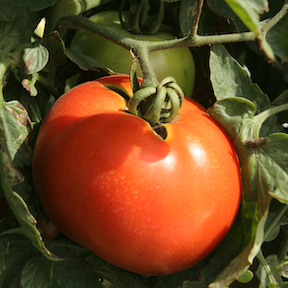The efficient use of fertilizer is a concern to those in and outside of agricultural production. Too much, or application at the wrong time, wastes resources for producers and can pose a risk to the environment. Researchers in the UF/IFAS Soil and Water Sciences Department (SWSD) are investigating the efficient use of nitrogen fertilization in tomato grown in sandy soils.

Florida ranks first in U.S. tomato production, according to the U.S. Department of Agriculture. In 2018, the Florida crop covered approximately 30,000 acres.
“Tomato production systems involve intensive management of nutrients and water on typically sandy textured soils,” said Dr. Rao Mylavarapu, SWSD professor of sustainable nutrient systems. “Optimizing efficiencies is important for minimizing potential losses of nutrients to the environment, particularly nitrogen, in sandy soils.”
The study measured the nitrogen (N) use efficiency (NUE) and apparent recovery of nitrogen fertilizer (APR) to determine how efficient the nitrogen application was. The tomato plants (Solanum lycopersicum) were grown in sandy soils under a fertigated plastic-mulched bed system. Ammonium nitrate was the nitrogen source applied at four different rates (0, 150, 200, and 250 lb/acre). Spring tomato was followed by fall tomato in the same field, which is a typical cropping sequence in north Florida.
“NUE significantly decreased with increasing rates of nitrogen fertilizer applied in both seasons, which is a typical result in many N fertilizer rate studies,” said Laura Jalpa, SWSD doctoral student.
For APR, which is the difference in nitrogen accumulation (pounds per acre) between fertilized and unfertilized plots, in proportion to the amount of fertilizer applied, the values were similar among the three applied nitrogen rates during each season.
“While the data showed that the 150 pounds per acre nitrogen rate was adequate to meet the overall crop nitrogen requirement,” Jalpa explained, seasonal differences are commonly observed in the field for crop production.
That means yields were optimized at 162 and 233 pounds per acre nitrogen in the spring and fall seasons, respectively, averaging at 198 pounds per acre between the two seasons. That rate closely matches the 200 pounds per acre nitrogen rate that UF/IFAS currently recommends for tomato production in Florida.
Jalpa said further long term, multiyear/seasonal trials may help validate the N recommendations for effective nutrient management in the tomato production systems.
You can read the full research study in the journal HortTechnology from the American Society for Horticultural Science.
 0
0
